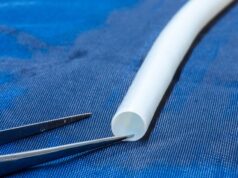
By Mark S Whiteley
Since the NICE (National Institute for Health and Care Excellence) guidelines for the treatment of varicose veins was published in July 2013, endovenous thermal ablation has now “come of age”. Recommended as the first line treatment for symptomatic varicose veins of truncal origin, it is essential that every doctor practising varicose vein surgery has a good understanding of the principles of endovenous thermoablation.
This is particularly important as there are different technologies and a wide range of different products, all labelled “catheter-based endovenous thermoablation”. Provided we understand the principles, then it becomes easier to ensure excellent results regardless of the technology generating the heat.
The general principles of thermoablation can be boiled down (no pun intended) to a few concepts, working through which we can answer the question posed in the title.
Firstly, at a very basic level of physics, heat is heat and in endovenous surgery, it is all basically the same. Although temperature was thought to be important in the early days of endovenous thermoablation when people thought collagen contraction was the mechanism of venous closure, we now measure the total energy transferred to the vein wall in joules per centimetre of vein. This is called the LEED—the Linear Endovenous Energy Density.
However, an optimal LEED achieved in a vein treatment by itself does not guarantee successful ablation of the target vein. If blood or excess fluid remains within the vein lumen, the measured energy transmitted from the thermoablation device will not all reach the vein wall, resulting in inadequate treatment despite a seemingly normal LEED.
Furthermore, the thermal energy introduced via the endovenous catheter must be applied at a rate that allows diffusion of the heat energy through the vein wall, allowing complete transmural treatment without causing tissue carbonisation at the intima which might act as a barrier to heat energy penetrating the vein wall, result in the endovenous device getting stuck to the vein wall. Thus total heat energy getting into the vein wall, the rate at which it is applied and the distribution of the heat within the vein wall are all essential components of successful endovenous thermoablation.
Turning to catheter design, the simple answer is “yes”—it does matter. The basic requirements that all endovenous thermoablation catheters require are the ability to be passed up the lumen of the target vein, to be able to be imaged to ensure accuracy of treatment, to have markings on the shaft to ensure proper pull-back protocols depending on the method being used and then the ability to pass thermal energy into the vein wall.
This last point, the treatment “tip” is of course the most important part of the catheter design. Depending on the technology used, the tip might need direct contact with the vein wall for thermal conduction, such as in the hot tip of the Venefit (formally VNUS Closure FAST), or just contact for heat to be generated by the passage of alternating currents at radiofrequency rates, such as with the bipolar RFiTT or the monopolar EVRF.
Of course with laser and steam, direct contact is not required, but the way the energy is radiated, forward firing or radial firing for laser or orientation of ports with steam, dictate the tip design.
Thus for successful endovenous thermoablation, sufficient heat energy needs to be transmitted to the vein wall in an optimal manner, and catheter design and technique of use are essential to get optimal results.
Mark S Whiteley, The Whiteley Clinic, Guildford, UK












